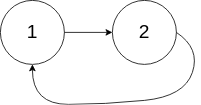环形链表 II
给定一个链表,返回链表开始入环的第一个节点。 如果链表无环,则返回 null。
为了表示给定链表中的环,我们使用整数 pos 来表示链表尾连接到链表中的位置(索引从 0 开始)。 如果 pos 是 -1,则在该链表中没有环。注意,pos 仅仅是用于标识环的情况,并不会作为参数传递到函数中。
说明:
- 不允许修改给定的链表。
进阶:
- 你是否可以使用 O(1) 空间解决此题?
示例 1:

1 | 输入:head = [3,2,0,-4], pos = 1 |
示例 2:

1 | 输入:head = [1,2], pos = 0 |
示例 3:

1 | 输入:head = [1], pos = -1 |
提示:
- 链表中节点的数目范围在范围 [0, 104] 内
- -105 <= Node.val <= 105
- pos 的值为 -1 或者链表中的一个有效索引
- 来源:力扣(LeetCode)
- 链接:https://leetcode-cn.com/problems/linked-list-cycle-ii
- 著作权归领扣网络所有。商业转载请联系官方授权,非商业转载请注明出处。
代码:
100%98%
1 | /** |
